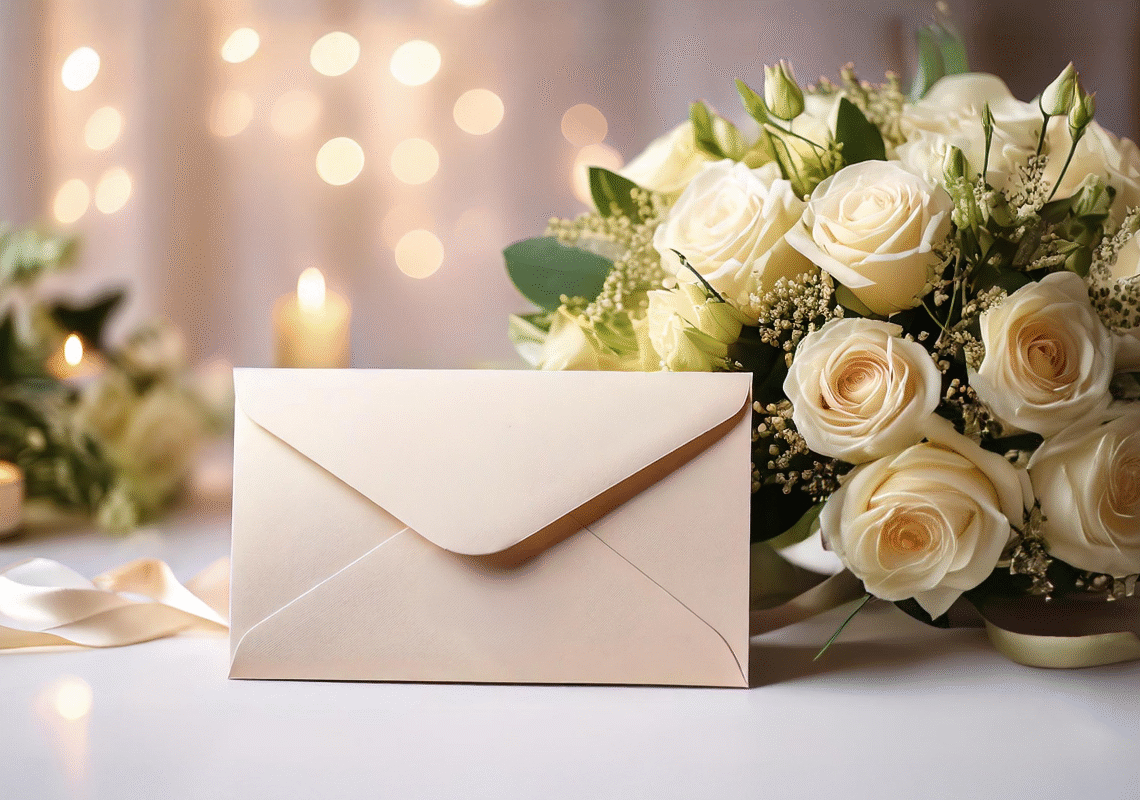
10 Common Wedding Invitations Mistakes
For many guests, your wedding invitations will be their first—and possibly only—glimpse of what to expect before the ceremony. They’ll form impressions, expectations, and excitement based entirely on this one element. Your role isn’t just to inform guests about the event, but to make a strong first impression.
Invitations are an important part of your wedding planning, helping set the tone for what’s to come. Thoughtful organization here can help everything get off to a smooth start.
The Most Frequent Wedding Invitation Mistakes to Watch For
To help you navigate the process, here’s a list of the most important things to do—and what to avoid. While you can’t predict every detail or prevent all last-minute surprises, you can take steps to make your day memorable for the right reasons.
From choosing the right time to send invitations and including essential information, to providing clear RSVP instructions—every detail matters.
Don’t worry: once you understand these common mistakes, you’ll feel more confident that your invitations will set the stage for a beautiful celebration.
1. Leaving Out Important Details
Start with all the essential details so that your guests won’t be confused and won’t need to call for more information.
On the wedding invitation itself, you should include:
- the hosts name,
- the couple’s names,
- the guests’ names,
- the type of event they’re invited to (whether it’s the ceremony, reception, or both),
- the date and time,
- the venue.
Optionally, directly on the wedding invitation, you can also include:
- RSVP information,
- the dress code,
- your website address.
While these may be considered optional for the invitation itself, it doesn’t mean they are optional overall.
Think of the RSVP details and dress code as basic information. The only part that is not required is the one regarding the website.
Traditionally, the host is the person or people who are paying for the wedding. In many cases, this might be the bride and the groom themselves, but it’s also common for parents or other family members to take on this role.
If you’re not including this information directly on the invitation, consider using RSVP cards, details cards, or even a map if needed. Regardless of how you choose to present it, make sure that all the essential information is printed. Don’t assume that guests will visit your website for details, as many of them may not do so.
If you decide not to use RSVP cards or details cards, any necessary information should be included on the wedding invitation itself, but keep it brief.
2. Sending Invitations Too Late or Too Early
Getting the timing right for your wedding invitations is super important. Ideally, they should be sent 6 to 8 weeks before the wedding date.
For destination weddings or events where many guests will need to travel, it’s best to send invitations 3 to 4 months in advance.
Either way, give your guests enough time to RSVP and make the necessary arrangements to be able to attend.
Just keep in mind that sending invitations too early might make your guests feel like they have plenty of time to plan. With their busy lives and many commitments, it may slip their minds as they focus on more immediate concerns.
On the flip side, sending invitations too late can leave guests feeling rushed and unprepared. As a result, they may miss out on your special day.
This is easily predictable, which means you don’t have to put much time and effort into preventing it from happening.
There’s no doubt your wedding is significant to you. While planning, you just have to realize that for others it may not be as big of a priority in their lives. Your loved ones care about you, but also have other responsibilities that require their attention. Think about the right timing to make sure they have enough time to get ready and look forward to celebrating with you.
3. Asking For Money or Gifts
A wedding invitation is not the appropriate place to ask for any gifts, including money. When guests read your invitation, they should not encounter any mention of gifts. This means you shouldn’t write “No gifts, please” either.
Across cultures, it is a polite gesture to bring gifts, so it’s understood that guests won’t come empty-handed. However, directly requesting money can be perceived as impolite or greedy. This may make guests feel pressured to contribute financially.
Mentioning gifts in the invitation suggests that you are not only inviting them but also expecting something in return.
Moreover, asking for money can create discomfort for guests who may not be able to give much. For some, placing a smaller amount of money in an envelope may feel awkward or embarrassing, to the point where they might hesitate to attend your wedding. There’s a difference between giving $50 in cash and presenting a book with a handwritten dedication, a bottle of wine, or another thoughtful gift. Something may be less expensive, but the sentimental value of a meaningful present often outweighs the cost.
There are various ways to communicate the types of gifts you would appreciate. It would be helpful for your guests to know your preferences, allowing them to save time and energy in selecting something that might not ultimately be useful for you. That said, don’t mention gifts whatsoever in your invitation.
4. Not Informing About the Dress Code
A dress code is often overlooked and seen as unimportant, which is a mistake. You may hesitate to tell your guests what to wear out of concern for offending them, but specifying what’s expected still gives everyone flexibility within the guidelines.
Many guests wonder whether their planned outfit is appropriate for the occasion. A wedding ceremony is generally a formal event, and while we can often determine what’s suitable in terms of color or length, much depends on the specific dress code. For example, what’s acceptable for a smart-casual beach wedding wouldn’t be appropriate at an elegant restaurant, where cocktail attire is required.
Clearly informing your guests about the dress code will help them choose the right attire and avoid being underdressed or overdressed. It also prevents any last-minute calls or questions, keeping everyone focused on celebrating instead of worrying about what to wear.
The dress code is a key detail and should be on the invitation, but if you opt to leave it off, a details card is a good place to share this information.
5. Not Clarifying Who Is Invited
One of the most common mistakes couples make when sending out wedding invitations is not making it clear who is invited in the first place. This can lead to confusion and misunderstandings among your guests.
For instance, if you are inviting an individual, specify whether they can bring a guest. If you are inviting a family, mention all family members by name or use phrases like “The Smith Family” to indicate that everyone in that household is welcome.
Not providing clarity can create awkward situations. Guests may feel unsure whether to bring their significant others, children, or a friend. This lack of communication can lead to some guests feeling excluded, while others might show up with unexpected plus-ones.
To avoid these misunderstandings, make sure your invitations directly state who is invited. Be specific not just on the invitation itself, but also on the outer and inner envelopes, if you’re using one.
Remember, communication sets the right expectations and helps ensure that your wedding day is filled with the people you want to celebrate with.
6. Not Providing Clear RSVP Instructions
To keep things organized, provide clear guidance on how and when to respond. Include a “Please respond by” date and add pre-addressed, stamped envelopes.
Consider offering multiple ways for guests to respond, not just one. Allow them to reply via the RSVP card or email. They could also have the choice to make a phone call or complete an online RSVP form on your wedding website.
Just be mindful that too many options can become overwhelming and difficult to track. Give your guests flexibility, but ensure the process remains manageable for you as well.
Set your RSVP deadline at least 3 to 4 weeks before the wedding day. If you send your invitations 6 to 8 weeks before the wedding, it will give your guests enough time to plan ahead or arrange travel. Having this information early enables you to give your caterer the details they need, as well as arrange logistics such as hotel room reservations, parking, and seating arrangements. For destination weddings, consider extending the RSVP period to 6–8 weeks.
The goal is to make the RSVP process as quick and simple as possible. The easier it is for guests to respond, the less time you’ll need to spend chasing down those who haven’t replied.
7. Not Including Stamps on the RSVP Envelopes
As a general etiquette rule, you should include self-addressed, stamped envelopes for your RSVPs. This detail should be factored into your wedding budget, as guests should not be expected to pay for postage.
This small gesture simplifies the process for your guests, making it easier for them to fill out the RSVP card, place it in the envelope, and send it back. The more prepared you are, the greater the likelihood of receiving their replies.
However, keep in mind that postage regulations vary by country, so it’s important to consider your international guests. For them, mailing rules may differ, making the use of stamps impractical. For them, mailing rules may differ, making the use of stamps impractical. If this is the case, providing an alternative method for them to RSVP—such as a digital option—could be helpful.
If you’re having trouble finding reliable information about postage options, consider reaching out directly to your international guests to ask about the methods they typically use. This will make it easier to choose the most convenient option for them.
But remember, it’s your wedding, so unless it’s absolutely necessary, handle these details without involving your guests in the logistics.
8. Typos and Spelling Errors
Minor typos and spelling errors may not seem like a big deal, but more significant ones can take extra time and money to fix.
Misspellings—especially of names and locations—can cause confusion. That’s why it’s very important to have several people proofread your invitations before printing to catch any errors you might overlook.
Be sure to double- or triple-check all contact information, including phone numbers, website addresses, and email addresses. Also, verify that the date and time of both the ceremony and reception are accurate.
Discovering an incorrect date or time after sending invitations might require more than just a quick message to your guests. In some cases, you’ll need to resend invitations to make sure everyone has the correct details on paper.
Making a mistake, like misspelling someone’s name, is not the end of the world. Sending a new invitation would be a nice gesture, but even a simple phone call and apology can go a long way. Your guests will probably understand how many details you and your partner are juggling, and mistakes happen to everyone.
Just keep in mind: if a name was misspelled on the invitation, it’s likely also misspelled on the escort card or any other printed materials. Be sure to correct it in time for the event.
9. Adding Too Much Information
While it’s important not to leave out key details, overloading your invitation with excessive information can be just as problematic.
The primary purpose of your invitation is to communicate the essentials, such as date, time, and venue.
Avoid overwhelming your invitation with unnecessary details like registry information, directions, parking, or accommodation options. Wedding invitations should be simple and to the point. For additional information, include a details card or direct guests to your wedding website. This keeps the invitation elegant and uncluttered while ensuring your guests have access to all the necessary information.
Although a details card or wedding website works well for sharing extra information, it’s still essential to keep things organized and to the point. Don’t overload them with excessive content, as it can make it harder for guests to find what they truly need. Prioritize information relevant to most guests, and trim unnecessary extras. This way, you’ll keep your wedding communication elegant, accessible, and easy for guests to navigate.
10. Ignoring the Cohesive Theme or Style
The theme, color scheme, style, font, and wording of your invitations set the tone for your wedding and give your guests an idea of what to expect.
Focus on a primary style, whether it’s rustic, romantic, whimsical, glamorous, casual, or simply traditional. Keep in mind that the venue also plays a role—the atmosphere at a garden, beach, or restaurant will be different. Invitations should align with the setting, so choose a design that reflects the overall feel of your big day.
Ensure the dress code aligns with your wedding’s theme so that your guests know exactly what to wear. Sending very elegant invitations with information about a “semi-casual” dress code for a beach wedding could confuse your guests. The formality of the invitation might lead them to believe they should dress more formally, despite your intention for a more laid-back celebration. They might end up dressing as if they were attending a different ceremony.
If you’re having trouble deciding on just one style, you can try to coordinate elements from different ones. However, not all wedding themes complement each other, so be mindful of the overall effect.
A wedding is typically a formal occasion, but if you prefer a more relaxed atmosphere, consider using a casual tone. Just avoid mixing formal and casual elements, as it can lead to misunderstandings.
Making a Great First Impression with Your Invitations
Your wedding invitations are more than just an announcement—they’re the first impression guests will have of your big day. By avoiding common mistakes and planning thoughtfully, you can make sure that impression is a strong one. From timelines and tone to clarity and etiquette, getting the details right early on will save you time, prevent confusion, and show your guests they’re truly valued.
Keep things organized, communicate clearly, and remember: it’s not just about the look of your invitations, but what they say—both literally and symbolically—about your celebration.
FAQ
Q: What essential details should be included on our wedding invitation?
A: Your wedding invitation should include the hosts’ names, the couple’s names, the event type (ceremony, reception, or both), date, time, and venue. You can also include RSVP information, dress code, and your wedding website URL, but don’t overwhelm the invitation with too much detail. Consider including extra info on RSVP cards or a details card.
Q: When is the best time to send out wedding invitations?
A: Send your invitations 6 to 8 weeks before the wedding. For destination weddings, send them 3 to 4 months in advance to give your guests enough time to make travel arrangements.
Q: Can I ask for money or gifts in the wedding invitation?
A: No, it’s not appropriate to directly ask for gifts, including money, on the wedding invitation. If you have preferences for gifts, communicate this on your wedding website or through word of mouth.
Q: How do I inform guests about the dress code?
A: Traditionally, the dress code is often placed in the lower right corner of the invitation. This spot helps keep the main event details, such as date, time, and location, the focal point, while still giving guests clear instructions about attire. If more details are needed, you can include them on a separate details card or on your wedding website.
Q: Should I include postage for RSVP cards?
A: Yes, always include self-addressed, stamped envelopes for your RSVP cards. This makes it easy for your guests to send their responses back to you. For international guests, consider offering an online RSVP option or checking with them about local postage practices.


